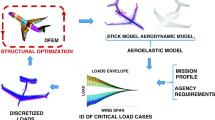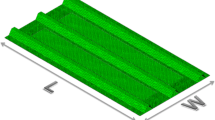Abstract
An iterative global approximation technique based on the Kriging method is proposed. The technique is validated through analytical test cases and then applied to solve two practical optimization problems: the optimization of aluminium-foam filled absorbers against crashworthiness requirements and the optimization of composite stiffened panels against buckling and strength constraints. The absorbers of the first application consist of two co-axial aluminium alloy tubes filled with lightweight aluminium foam. They were optimized to collapse at a controlled force level and to be the lightest possible. Explicit Finite element analyses were performed to evaluate the structural behavior of the absorbers in the sample points used to build the approximation. In the second application stiffened panels were optimized against buckling and strength constraints. The Tsai-Wu criterion was used to estimate first-ply failures as strength limit of the structure. Non-linear Riks analyses were performed with ABAQUS/Standard to evaluate the shell behavior in the sample points used to build the response surfaces. Basing on the obtained results the proposed iterative procedure seems a promising alternative to the classic a-priori building of response surface allowing better accuracy and saving of sample points.
Similar content being viewed by others
References
Abaqus (1998) Abaqus® theory and users’ manuals. Hibbitt, Karlsson & Sorensen, Pawtucket
Arbocz J, Starnes JH Jr (2002) Future directions and challenges in shell stability analysis. Thin-Walled Struct 40:729–754
Blazy JS, Marie-Louise A, Forest S, Chastel Y, Pineau A, Awadec A, Grolleron C, Moussy F (2004) Deformation and fracture of aluminium foams under proportional and non proportional multi-axial loading: statistical analysis and size effect. Mech Sci 46:217–244
Carpenter WC, Barthelemy JFM (1993) A comparison of polynomial approximations and artificial neural nets as response surfaces. Struct Optim 4:166–174
Chirwa EC, Lehmhus D, Mao M, Chen T, Lanzi L (2005) Mechanics of lightweight aluminium foam wrapped in carbon fibre reinforced composites. In Alves M, Jones N (eds) Impact loading of lightweight structures. WIT Press
Chung HS, Alonso JJ (2002) In: 9th AIAA/ISSMO symposium on multidisciplinary analysis and optimization, Atlanta, USA, 4–6 September 2002. AIAA, Washington, pp 1–21
Coello CA, Christiansen AD (2000) Multiobjective optimization of trusses using genetic algorithms. Comput Struct 75:647–660
Deb K (2005) A population-based algorithm-generator for real-parameter optimization. Soft Comput 9:236–253
Goldberg DE (1989) Genetic algorithms in search, optimization and machine learning. London, Addison-Wesley
Hallquist JO (2001) LS-DYNA keyword users manual, version 960, vols I and II. Livermore Software Technology Corporation
Hussain MF, Burton RR, Joshi SB (2002) Metamodeling: radial basis functions, versus polynomials. Eur J Oper Res 138:142–154
Jin R, Chen W, Simpson TW (2001) Comparative studies of metamodelling techniques under multiple modeling criteria. Int J Struct Multidiscipl Optim 23:1–13
Jones RM (1999) Mechanics of composite materials. Tailor & Francis, London
Jurecka F, Bletzinger KU, Ganser M Update schemes for global approximations in robust design optimization. In: Proceedings of the 6th world congress of structural and multidisciplinary optimization, Rio de Janeiro, Brazil, 30 May–03 June 2005, pp 1–10
Khoo LP, Chen CH (2001) Integration of response surface methodology with genetic algorithms. Int J Adv Manuf Technol 18:483–489
Lanzi L (2004) A numerical and experimental investigation on composite stiffened panels into postbuckling. Int J Thin-Walled Struct 42:1645–1664
Lanzi L, Bisagni C, Ricci S (2004) Neural network systems to reproduce crash behavior of structural components. Comput Struct 82:93–108
Levin D (1998) The approximation power of moving least-squares. Int J Math Comput 67:1517–1531
Martin JD, Simpson TW (2002) Use of adaptive metamodeling for design optimization. In: Proceedings of the 9th AIAA/ISSMO symposium on multidisciplinary analysis and optimization, Atlanta, 4–6 September 2002. AIAA, Washington, pp 1–9
Matlab (2002) Matlab® user manuals, Matlab 6.3, version 5. The Math Works, Natick
Mayers RH, Montgomery DC (1995) Response surface methodology: process and product optimization using designed experiments. Wiley, New York
Nagendra S, Jestin D, Gürdal Z, Haftka RT, Watson LT (1996) Improved genetic algorithm for the design of stiffened composite panels. Comput Struct 58:543–555
Nemeth MP, Starnes JH Jr The NASA monographs on shell stability design recommendations: a review and suggested improvements. NASA TP-1998-206290
Rafiq MY, Bugmann G, Easterbrook DJ (2001) Neural network design for engineering applications. Comput Struct 21(17):1541–1552
Rikards R, Abramovich H, Auzins J, Korjakins A, Ozolinsh O, Kalnins K, Green T (2004) Surrogate models for optimum design of stiffened composite shells. Compos Struct 63:243–251
Riks E (1972) The application of Newton’s method to the problem of elastic stability. J Appl Mech 39:1060–1065
Riks E (1979) An incremental approach to the solution of snapping and buckling problems. Int J Solid Struct 15:529–551
Sacks J, Welch WJ, Mitchell TJ, Wynn HP (1989) Design and analysis of computer experiments. Stat Sci 4:409–435
Seitzberger M, Rammerstorfer FG, Degischer HP, Gradinger R (1997) Crushing of axially compressed steel tubes filled with aluminium foam. Acta Mech 125:93–105
Thornthon PH (1980) Energy absorption by foam-filled structures. SAE paper 800081
Weiyu L, Batilly SM (2002) Gradient-enhanced response surface approximations using Krgiging models. In: 9th AIAA/ISSMO symposium on multidisciplinary analysis and optimization, Atlanta, USA, 4–6 September 2002. AIAA, Washington, pp 1–11
Wiggenraad JFM, Arendsen P, da Silva Pereira JM (1998) Design optimization of stiffened composite panels with buckling and damage tolerance constraints. AIAA-98-1750, pp 420–430
Author information
Authors and Affiliations
Corresponding author
Rights and permissions
About this article
Cite this article
Lanzi, L., Airoldi, A. & Chirwa, C. Application of an iterative global approximation technique to structural optimizations. Optim Eng 10, 109–132 (2009). https://doi.org/10.1007/s11081-008-9044-4
Received:
Accepted:
Published:
Issue Date:
DOI: https://doi.org/10.1007/s11081-008-9044-4




